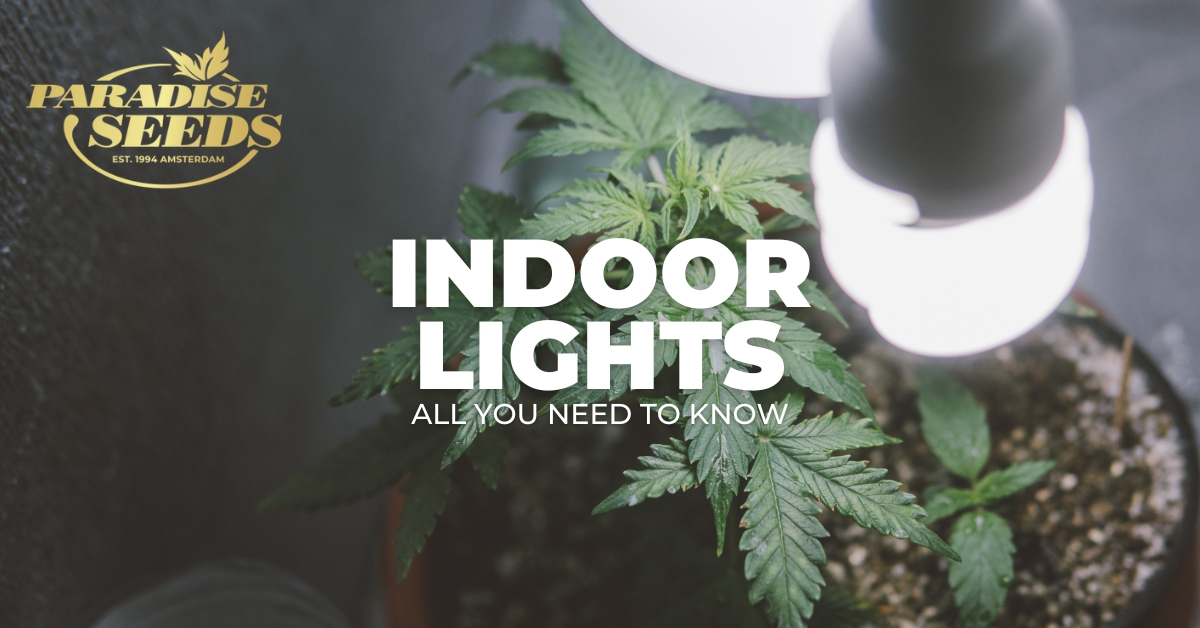Light, soil and water are the holy trinity for healthy plant growth. If you ask experienced growers which of these is the most important for high yields, most would say that it’s light, without any hesitation. For this reason indoor grow lights
When it comes to outdoor plants, the importance of light cannot be overstated. The sunnier and warmer the environment, the better the yields. This is due to photosynthesis, which converts light into energy and food for the plants. Unlike water and other nutrients, sunshine cannot be rationed.
When preparing to grow plants indoors, one of the first decisions you’ll need to make is what type of light sources to use. The answer depends on various factors, such as the type and amount of plants you plan to grow, the size of the growing space, the desired yield, the length of the growing cycles, and the amount of money you’re willing to spend on energy consumption.
Even if you don’t have all the answers, it’s helpful to understand the main types of light sources available to help you with your planning.
Indoor grow lights for cannabis cultivation
Indoors, you have complete control over your plants, especially the light they receive, which also allows the cultivator to employ numerous cannabis grow techniques. Unlike outdoor cultivation, where yield is primarily determined by location and timing of planting, indoor growers can significantly optimize their yield by maximizing light exposure.
Just like outdoors: the more light your plants receive, the greater your yield will be. When setting up an indoor grow system, from a home basement or attic setup to a small stealth space, most growers consider two types of indoor grow lights: HPS (high-pressure sodium) and LEDs (Light Emitting Diodes).
While there are ongoing debates about which is best, it’s worth taking a fresh look at the issue in light of recent advances in LED technology and affordability.
To help you make an informed decision around installing indoor grow lights, we’ve compiled a summary of the features, advantages, and disadvantages of both types of lights. But before choosing the right light, it’s essential to consider the importance of the light spectrums in the plants’ lives.
The role of the light spectrum in plant growth stages
Indoor growing poses the challenge of mimicking the sunlight spectrum for optimal plant growth. The better the lights imitate sunlight, the healthier the growth of the plants.
Light is measured in nanometers and represents the range of wavelengths of electromagnetic radiation visible to the human eye. This range is from 380 to 750 nanometers, which is 790-400 terahertz (THz) in frequency.
Visible light colors range from violet (400 nm) to far-red (700 nm), while ultraviolet (300 nm) and infrared (800 nm) are invisible to the human eye. Plants perceive light on a broader spectrum than humans; hence, these wavelengths must be present at the right growth stage to ensure healthy growth.
During the vegetative stage, plants require bluish wavelengths (ultraviolet, violet, and dark blue) for healthy growth and leaf development. If the indoor light source lacks these wavelengths, it could damage the plant during the vegetative stage.
Red wavelengths (orange, red, and deep red) are necessary for flowering to increase photosynthesis, bud formation, and yield.
The spectrum emitted by each indoor grow light source determines the period of cultivation at which they can be used most successfully.
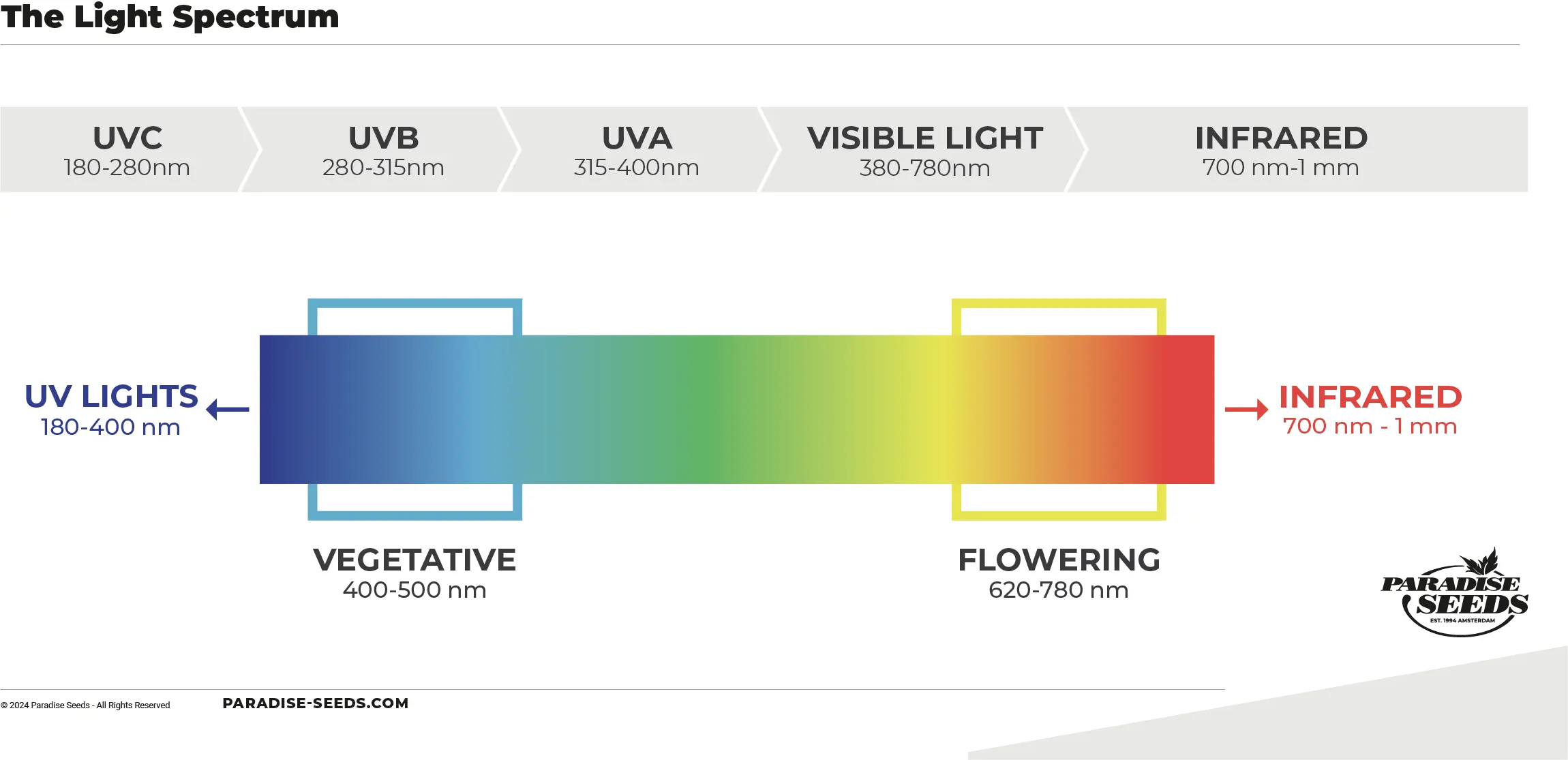
HPS lights – serving cannabis growers for 30 years
The HPS is a subcategory of the HID (high-intensity discharge) lamps. It is a popular classic among indoor growers due to its ability to produce spectacular yields. HPS lamps were first used as street lights in the 1970s, but gained popularity as indoor grow lights among growers in the 1990s. Many growers still prefer to use HPS lights today, and this technology is expected to continue to be used in many grow rooms.
HPS lights are favored by growers for their ability to produce large amounts of light and their broad color temperature spectrum. Their high intensity and powerful orange/red spectrum light, due to the sodium content, provide an ideal environment for cannabis to flower. During the vegetative phase, growers often use Metal Halide (MH) lamps instead, as their cooler, bluish light is more suitable for supporting plant growth.
During the vegetative phase, plants that receive strong light from HPS lamps tend to grow taller. However, this may not be desirable in most grow rooms. HPS indoor grow lights emit heat directly towards the plants, which means they need to be placed at a sufficient distance to prevent damage. This can limit the usable area of the grow room.
For medium-wattage HPS lights (400-600 watts), keeping a distance of more than one meter between indoor grow lights and the plants is advisable.
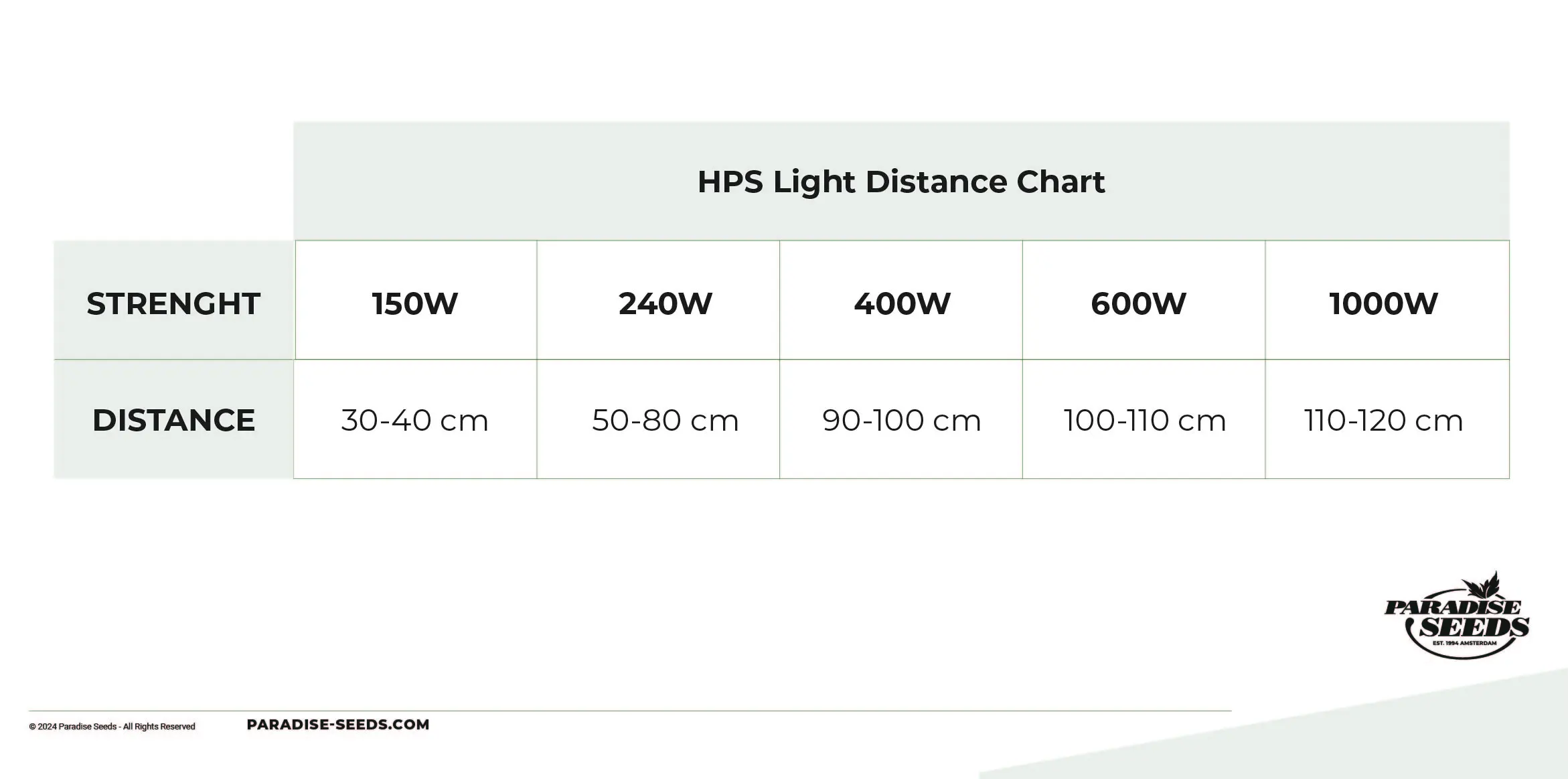
While you can find HPS lights up to 1000 watts, most growers recommend using two or three smaller 400-600 watt indoor grow lights instead. This allows for more precise positioning of the lights and ensures that each plant receives the right amount of light without damage.
HPS lamps are an affordable option for lighting setup, but their operation cost is not as economical. The high-intensity output of HPS lights generates significant heat, as most energy absorbed is not emitted as light but as heat. This can be beneficial in a colder growing room, but the high heat can harm the plants. Therefore, using HPS grow lights also necessitates an additional ventilation system to ensure adequate air circulation, significantly increasing costs.
Users of HPS systems as indoor grow lights may experience a decline in quality as time goes on. The bulbs lose brightness gradually over a few years and may compensate for this by consuming more power. When this happens, it’s worth considering replacing the bulb. However, this is not necessarily a big negative. The benefit of being able to replace individual elements of the system is that you don’t have to worry about installing a whole new lighting system if something fails or ages.
Pros of HPS indoor grow lights
- HPS technology has been tried and tested with countless positive experiences. Most growing books provide detailed information on the proper use of HPS lights, making it easy to find information for any size grow room.
- Although HPS technology has seen little evolution in the last decade, proven, high-quality lights are widely available, allowing you to customize your installation to your needs.
- If used at the right time, especially during the flowering phase, you can guarantee a high yield by following simple rules. The entry cost for HPS indoor grow lights is also lower than most other options.
- In case of a single failure or deterioration, HPS bulbs can be replaced individually, so you don’t have to give up your entire lighting system.
Cons of HPS lights
- HPS lights are less energy-efficient because they emit high levels of heat along with light. If you cannot regulate the temperature in your grow room with this heat, you must install a ventilation system, increasing costs.
- Due to the heat emitted by HPS lamps, you must keep them at an appropriate distance from your plants, which can result in a loss of useful space in your grow room.
- Additionally, HPS lights have a shorter lifespan and must be replaced periodically.
- It is recommended to use HPS indoor grow lights during the flowering phase only. For healthy plant growth during the vegetative phase, it is advisable to consider alternative light sources.
LEDs – light at the end of the tunnel
The introduction of LED technology in the growing industry has not been a triumph. The first generation of LED lights was out of reach for most growers due to their price, while they mostly lagged behind HPS lights in terms of efficiency. Initially, these lights were used most successfully for rooting and cloning and as such were considered a luxury.
However, LED technology has undergone significant advancements over the past decade. While the cost of LED indoor grow lights has decreased over time, their range of applications has widened, allowing better quality LEDs to be used in both the vegetative and flowering stages. In many cases, the light spectrum can be adjusted based on the stage of development.
Yet, it’s important to note that not all LED products are of good quality despite their shiny appearance. The absence of an industry standard has caused the market to be flooded with products marketed as premium LEDs, but are actually of poor quality. Therefore, it’s crucial to carefully check the quality of the LED lights before making a purchase.
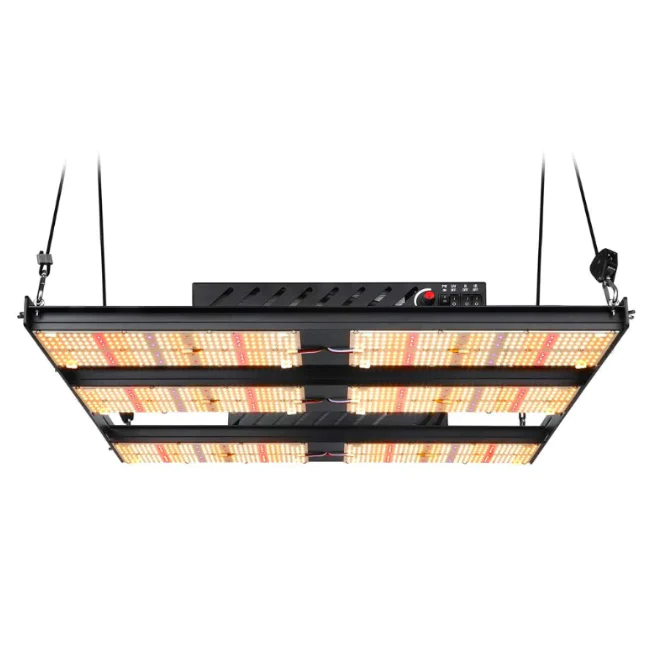
LEDs offer several advantages over HPS systems. One of the main benefits is their compact size, which requires less space in the grow room. Since they generate less heat than HPS lamps, they can be placed closer to the plants.
Another advantage is that even though both HPS and LEDs consume the same watts of power, LED lights emit very little heat, and thus have significantly lower ventilation costs if any at all. As a result, you can cultivate taller plants in the same-sized grow room using high-quality LEDs.
Another significant benefit of high-quality LEDs is their extended lifespan. Manufacturers may guarantee up to 50,000 hours of operation, equivalent to almost six years of continuous usage without any reduction in brightness, even if used for 24 hours a day.
Pros of LEDs
- The higher entry price of LED indoor grow lights is often recovered over their lifetime due to their energy efficiency in the grow room.
- LEDs don’t generate as much heat as HPS lights, so they don’t require as much ventilation. Their smaller size also allows them to be placed closer to plants, which increases the effective growing area.
- High-quality LEDs offer a stable, long-lasting operation.
- Numerous LEDs available can adjust their light spectrum to specific growing cycles, allowing them to be used throughout the entire growing process. Many growers report that plants grown under LED lights are healthier than those grown under HPS lamps.
- Unlike HPS, LED lights are “plug and grow,” meaning they don’t require a separate ballast, transformer, or light projector.
- There are tips to use to boost LED efficiency.
Cons of LEDs
- High-quality LED lights are still slightly more expensive than HPS lamps, which can make the initial cost higher.
- It is worth researching the LEDs you choose carefully, as many poor-quality lights are on the market.
- Low heat output can also be a disadvantage in colder growing rooms. In this case, proper heating should be ensured.
- Good quality LEDs with a wide range of applications are still relatively new, so less information is available on their optimal operation in different-sized growing spaces.
- In terms of yield, HPS still tends to come out on top.
Beyond the HPS/LED Universe
While the debate between HPS and LED indoor grow lights dominates, some think outside the box, and not without reason. Below, we briefly take stock of the other options for grow lights.
Metal Halide (MH) grow lights
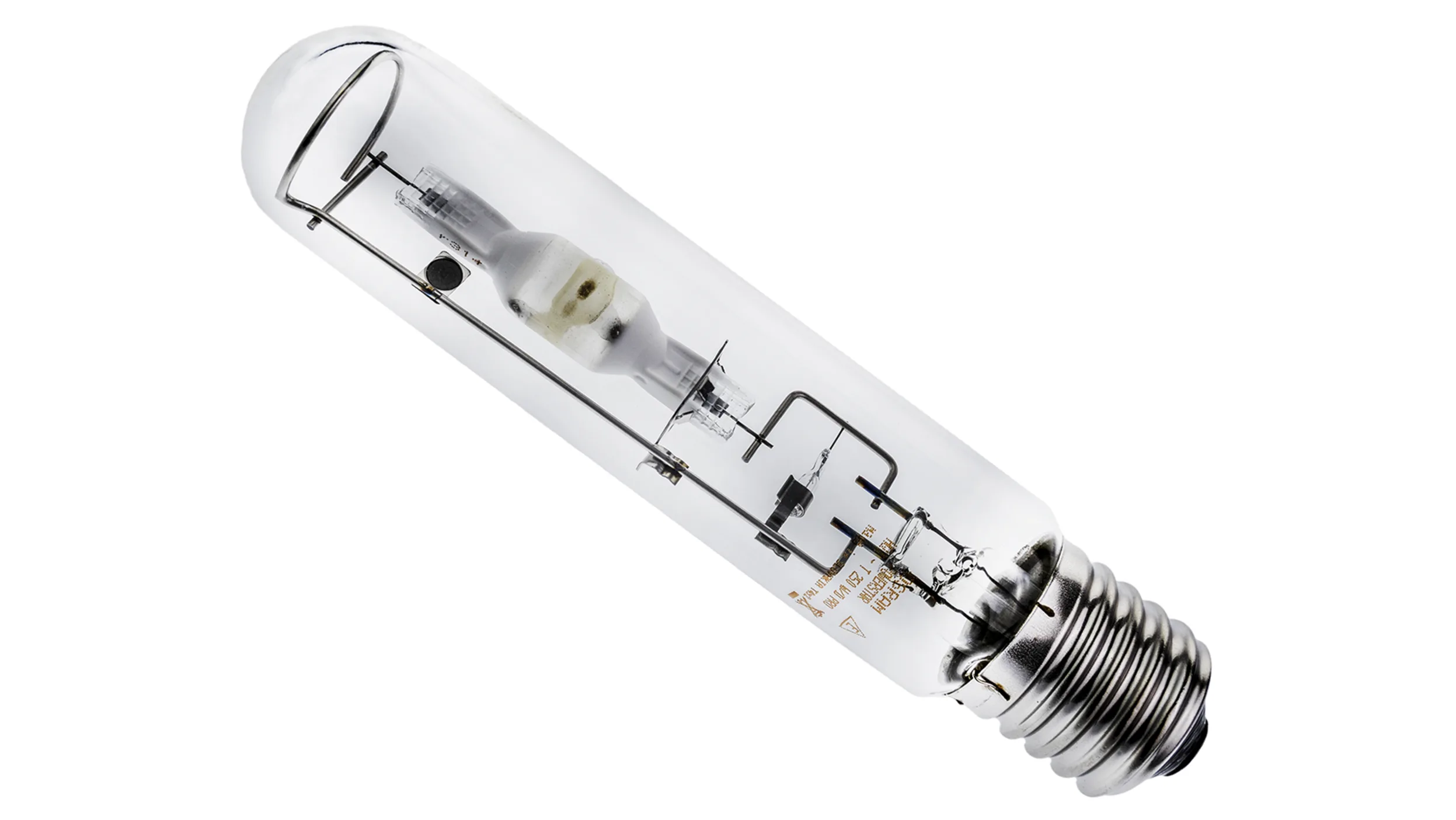
We have previously discussed MH (metal halide) lights, which, like HPS, are HID (high-intensity discharge) light sources. The primary characteristic of MH lights is the emission of cooler, bluish light.
This light spectrum imitates the spring and early summer sunlight, encouraging plants to grow as many leaves as possible in preparation for the flowering stage.
However, the same light spectrum is unsuitable during the flowering period. Overall, if you can only choose one of the two HID lights, it is worth considering HPS.
Ceramic Metal Halide (CMH) aka. Light Emitting Ceramic (LEC) grow lights
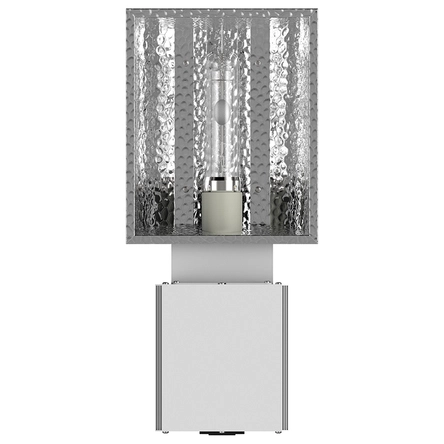
Although HID indoor grow lights have undergone advancements, CMH/LEC bulbs have emerged as a breakthrough. These bulbs combine the benefits of both MH and HPS lights and perform well in both the vegetative and flowering phases. CMH bulbs contain a different type of gas than HPS and MH lights, which results in higher yields.
Additionally, CMH bulbs offer a broader light spectrum, providing more consistent light for plants. Due to their higher color temperature, these bulbs can emit blue, red, and white light, making them suitable for usage throughout the plant’s life cycle.
CMH lights emit a specific type of ultraviolet radiation known as UV-B rays, which can benefit plants when provided in appropriate amounts. UV-B helps in photosynthesis and promotes faster growth during the vegetative phase.
One of the notable advantages of CMH lights over HPS bulbs is that they emit less heat, which means that they require less cooling and can be placed closer to the plants. However, despite its advantages, HPS bulbs are still considered more efficient in the flowering phase than CMH lights due to their higher lumen output.
Compact Fluorescent Lamp (CFL)
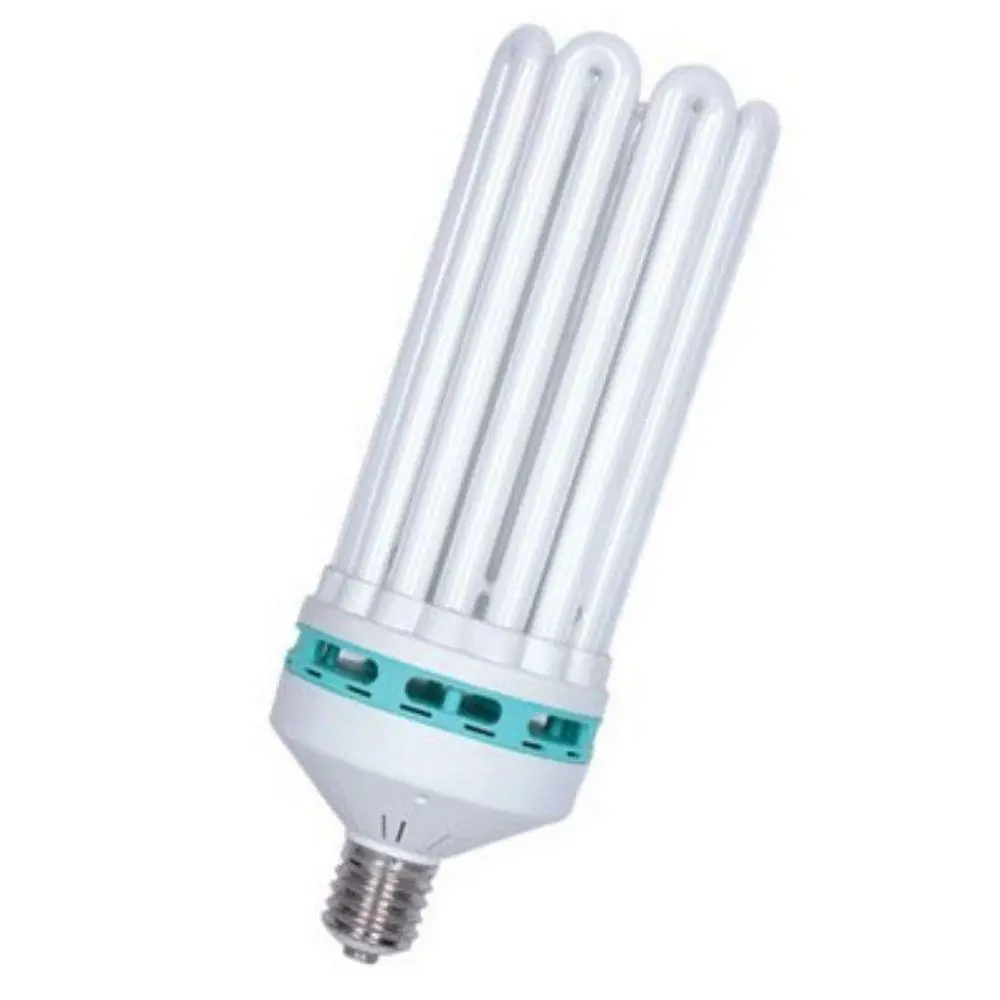
Compact fluorescent lamp (CFL) bulbs are energy-saving and inexpensive lighting options for growers, often used in homes. CFL bulbs are beginner-friendly and have several advantages over HID lamps. One is that they do not require a transformer to operate and emit much less heat, making them safer to use.
Additionally, they work well in small grow spaces where keeping the light at the ideal distance from the plants can be challenging. CFL bulbs can be placed ideally 20-30 cm from the plants as they are small and emit low heat.
These lamps are available in different light spectrums. The 6500K spectrum is recommended for the vegetative phase. For the flowering stage, the 2700K spectrum is a good choice.
However, CFL bulbs are only suitable for small-scale cultivation and are not as effective as the previously mentioned lights regarding yields. Unlike LEDs, CFL bulbs must be replaced after one year due to their shorter lifespan.
Conclusion
The rapid development of LED lights has thoroughly shuffled the cards for growers. While HPS lamps have not seen any significant technical lately, LEDs have become more reliable and affordable. Although HPS will continue to have a fan base, LED lights are winning over many serious growers.
Regardless of the lighting technology you choose, keep in mind that planting high-quality cannabis seeds in your grow room is the first step towards success and buying cheap seeds will undermine even the best lighting system!!


